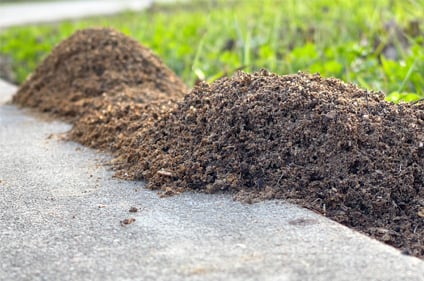Red imported fire ants or RIFA can be found from coastal North Carolina across the southern/ central US to Texas and a few other random spots in New Mexico and southern California.
These insects are native to central South America but have been introduced to the US between 1933 and 1945. There have been reports of RIFA as far north as Maryland and to the west through Kansas. Black imported fire ants are less populous, speckled around northern Mississippi and central/ western Tennessee.
Second in geographic coverage to the RIFA are hybridized or cross-bred red and black fire ants, covering most of northern Alabama, Georgia, and Mississippi, and the southern half of Tennessee. These species are all invasive or non-native while there are some indigenous species as well.
Most of the south and southeastern portion of the country is under federal quarantine to reduce the spread. These measures include inspection of nursery stock, sod, hay, and other articles to be shipped out of the quarantined areas.
Fire ants are social insects forming colonies around one or multiple queens. These queens take flight as temperatures rise in the spring and more often following a rainfall. They will mate and begin a new colony laying as many as 2,000 eggs per day. Workers build underground honeycomb colonies and pile excavated soil near the opening giving rise to the tell-tale mounds. Although the activity seems most prevalent near these mounds, they could be inhabiting tunnels several feet away.
Upon disturbance, angry ants will aggressively emerge from these tunnels looking to sting intruders. Fire ants do have stingers similar to those of a bee or hornet and will use them for protection. Sometimes they will actually bite the invader to hold themselves close while they sting and pump as much venom as they can. Sting sites can become red, irritated, itchy, or burn. These areas can end up as a pimple or pustule type of bump. Because they attack in groups, the victim could end up with several stings. Some individuals can have a similar allergic reaction to that of a bee sting and develop anaphylaxis, a severe life-threatening situation.
Although fire ants prey on flea larvae, chinch bugs, cockroach eggs, ticks, and other pests, they are considered a nuisance around the landscape or in pastures. Small animals can be harmed if nests are disturbed, and there have been reports of combine interference resulting in the inability to harvest areas of crops. For these reasons, one should look at control options.
Texas A&M University recommends their "two-step" method for ornamental areas and pastures provided products are labeled for those sites. Step One is broadcasting a bait over the entire property, and Step Two is mound treatment. The details are below.
Step 1. Baiting - Spread an approved fire ant bait throughout the property. There are faster acting materials including indoxacarb (Advion) and hydramethylnon (Amdro) which likely will need to be applied more often. There are also slower acting but longer-lasting materials in abamectin, fipronil, fenoxycarb, methoprene (Extinguish), and pyriproxyfen. Ants will pick up this bait, bring it back to the nest where the AI is extracted and fed to others including the queen. The slow reaction allows for more time, so most or all in the colony are able to ingest a lethal dose. Baiting is typically favored for large properties due to ease and economics. Also, baiting can control unseen mounds.
Step 2. Mound Treatments - Treat mounds individually in high traffic or sensitive areas. These treatments can be granular, dusts, drenches, or soil injections. They tend to be more expensive and labor intensive but can provide for rapid knockdown. Often treatments will include a synthetic pyrethroid (thrin) and can be followed up with a long-lasting material for residual control.
There are also combination products like Taurus Trio which combine pyrethroids for fast knockdown and fipronil for long residual control. Some of these, particularly fipronil or those containing that AI, are RUP or Restricted Use Pesticides requiring a license to purchase. Newer to the market is Siesta which touts fast knockdown and long residual activity in one bag.
For smaller yards, you can opt to go straight to Step Two particularly if there are singular or just a few mounds.
Whichever strategy you choose, read and follow label directions, and contact us if you need help.




